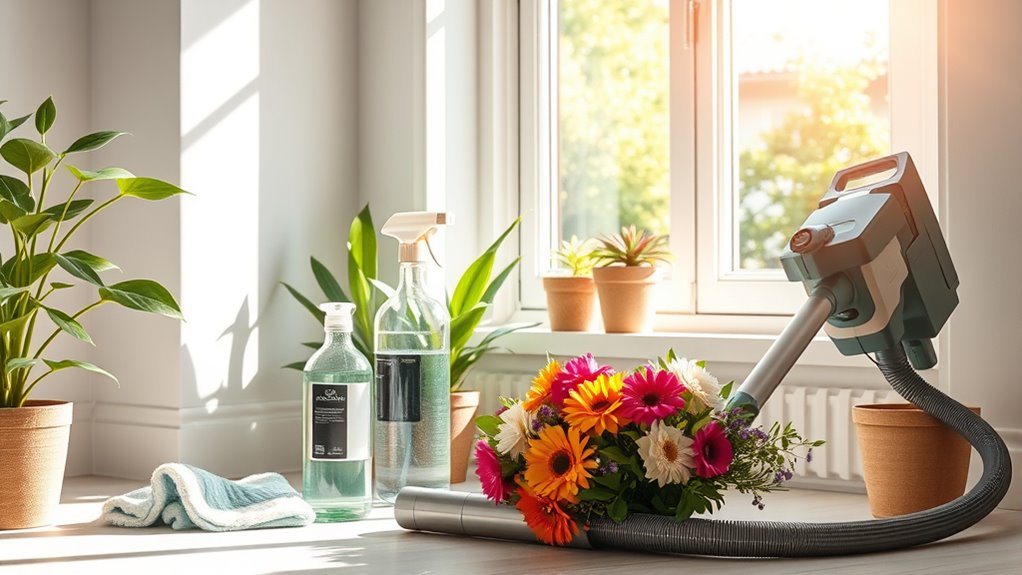Spring cleaning’s essential for allergy sufferers! Regularly dust and vacuum using HEPA filters to trap allergens. Wash bedding, upholstery, and curtains in hot water to minimize irritants. Control humidity below 60% to prevent mold growth, and consider using air purifiers. Remember to groom pets frequently and clean their areas to reduce dander. Take precautions outdoors during high pollen times. By maintaining a clean space, you can help improve your comfort and health. There’s more to explore about keeping your home allergy-free!
Key Takeaways
- Use microfiber cloths for dusting to effectively trap allergens and start from high surfaces, working downwards.
- Vacuum carpets and upholstery weekly with a HEPA-filter vacuum to capture allergens, including under furniture.
- Wash bedding, curtains, and pet items in hot water regularly to eliminate dust mites and pet dander.
- Maintain indoor humidity below 60% using dehumidifiers to prevent mold growth and improve air quality.
- Limit outdoor activities during high pollen times and wash hands and hair immediately upon returning indoors.
Importance of Spring Cleaning for Allergy Relief
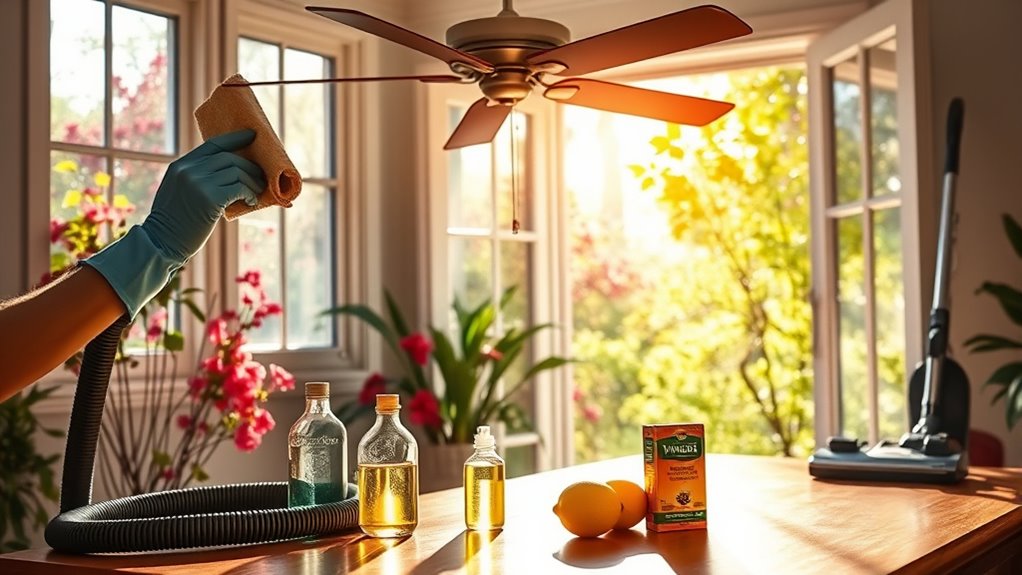
As spring arrives and pollen fills the air, tackling your spring cleaning can make a noteworthy difference for allergy sufferers.
By thoroughly cleaning your home, you can eliminate accumulated allergens like dust, pet dander, and mold, which often exacerbate allergy symptoms. Focus on washing bedding, curtains, and upholstery in hot water to effectively remove these irritants. Additionally, regularly checking and cleaning air purifier filters can significantly enhance the efficiency of your air purification efforts. Incorporating HEPA filtration in your cleaning routine can further help trap smaller allergens, ensuring cleaner air. Maintaining a clean environment also supports optimal indoor air quality, which is essential for alleviating allergy symptoms.
Thoroughly cleaning your home helps eliminate allergens like dust and pet dander, alleviating allergy symptoms effectively.
This effort notably improves indoor air quality, reducing sneezing and wheezing. Additionally, maintaining a clean environment helps prevent new allergens from settling in, allowing those with asthma or sensitivities to breathe easier. Regular vacuuming with effective filtration systems is essential to capture allergens and improve air quality.
Keep humidity levels below 60% to minimize mold growth and related triggers.
With spring cleaning, you’re not just tidying up; you’re creating a healthier space for yourself and your loved ones.
Managing Indoor Air Quality
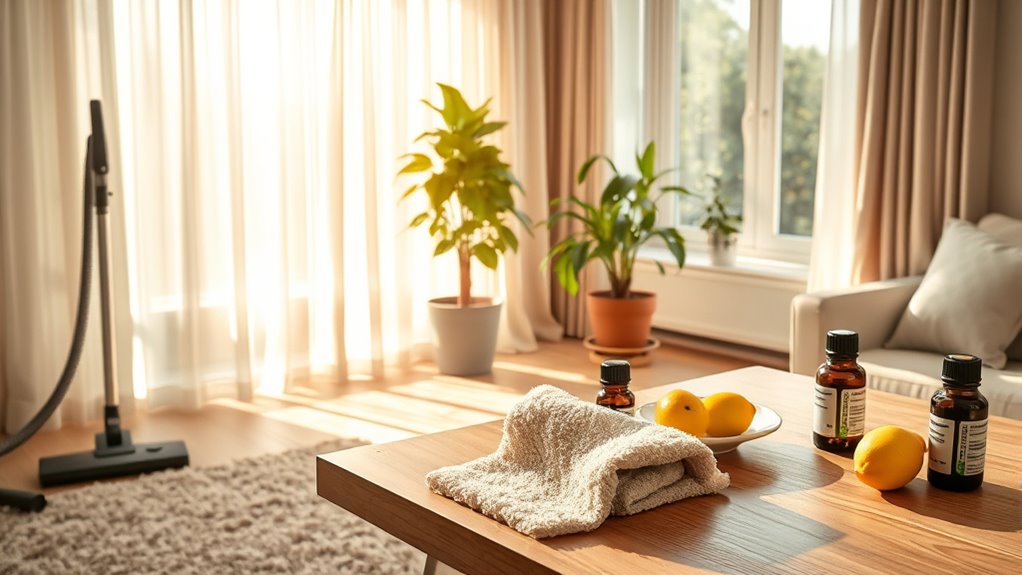
To manage indoor air quality, you need to control humidity levels and opt for natural fragrances.
Keeping humidity below 60% helps prevent mold growth, while using essential oils can replace chemical-laden air fresheners. Additionally, incorporating essential oils for respiratory health can further enhance air quality and promote easier breathing. Regularly using aromatherapy can also support mental clarity and emotional balance. Using dilution guidelines is crucial when applying essential oils to ensure safety and effectiveness. Moreover, maintaining regular cleaning of air purifiers is essential for optimal air quality.
Control Humidity Levels
Maintaining indoor humidity levels below 60% is essential for allergy sufferers, as it helps prevent mold growth that can worsen symptoms. Regular maintenance of your heat pump system can further enhance indoor air quality by efficiently controlling humidity levels. Additionally, energy-efficient heat pumps can provide better humidity regulation, contributing to a healthier indoor environment.
A dehumidifier is an effective tool to reduce moisture in damp areas like basements and bathrooms, greatly improving indoor air quality. Additionally, ensuring that your home has proper ventilation can help mitigate EV battery fires that may arise from high humidity and moisture exposure.
Regularly check and clean your gutters to prevent moisture accumulation, ensuring your home stays dry. During high pollen seasons, keep windows closed to limit the entry of outdoor allergens that thrive in humid conditions.
Additionally, use a hygrometer to monitor humidity levels, allowing you to know when to activate your dehumidifier or increase ventilation. Implementing advanced technology in your heating and cooling system can help maintain optimal humidity levels and improve overall indoor air quality.
Use Natural Fragrances
Using natural fragrances can considerably enhance your indoor air quality, especially for those with allergies. Instead of chemical air fresheners, try essential oils or organic air fresheners to keep your environment healthier. Cooking with aromatic herbs and spices can also infuse pleasant scents without harmful chemicals. Remember, maintaining indoor humidity below 60% reduces mold growth, which helps manage odors. Incorporating ingredients like chia seeds in your diet can also support overall health and wellbeing. Additionally, baked kale is rich in essential nutrients that can bolster your health during allergy season. Use natural deodorizers like baking soda or vinegar for effective odor control. Open windows for ventilation, but keep an eye on pollen levels to avoid triggering allergy symptoms. A diffuser with essential oils not only soothes the air but may also alleviate stress-related allergy symptoms. Additionally, you might consider incorporating natural remedies to further support your allergy management efforts.
Pet Allergy Management

Managing pet allergies starts with frequent vacuuming to reduce dander and fur in your home. Regular grooming of your pets, like brushing and bathing, can also keep allergen levels down. Consider using a vacuum designed for pet hair, such as the Dyson V11, to enhance your cleaning efforts. Additionally, ensure your vacuum has anti-allergen technology to effectively capture allergens and improve indoor air quality. Investing in a quality vacuum can also help mitigate the impact of seasonal promotions and discounts that make allergy management more affordable. Furthermore, understanding investment strategies can help you allocate funds towards better cleaning equipment.
Frequent Vacuuming Benefits
While you may love having pets around, their dander, fur, and saliva can trigger allergy symptoms if left unchecked. Frequent vacuuming is essential in managing pet allergens and reducing indoor allergens in your home.
Aim to vacuum at least once a week, or more often if you have multiple pets. Using a vacuum with a HEPA filter captures up to 99.97% of particles, effectively eliminating those pesky pet allergens. This practice not only helps control allergy symptoms but also keeps your indoor air quality pristine. Additionally, consider the benefits of professional cleaning for carpets to further enhance your allergy management efforts. Engaging in eco-friendly excursions can also promote a healthier environment for both you and your pets. Furthermore, teaching children the importance of digital literacy can help them understand how to manage pet allergies and navigate related challenges effectively. By incorporating high refresh rates in your home entertainment system, you can create a comfortable atmosphere that helps you relax while minimizing allergy triggers.
Don’t forget to complement vacuuming with washing upholstery and pet bedding to further reduce allergens. By staying proactive, you can enjoy your furry companions while minimizing their impact on your health.
Pet Grooming Techniques
To effectively manage pet allergies, regular grooming is key. Start by bathing your pets at least once a month with a hypoallergenic shampoo to reduce allergens like dander, pet hair, and saliva. Additionally, ensure your home has adequate ventilation to prevent dangerous gas buildup, as this can also improve overall air quality. Using mattress toppers can further enhance sleep quality by providing additional comfort and support, which is beneficial for allergy sufferers.
Make it a habit to brush your pets outdoors or in a specific area to keep allergens contained. Use grooming tools designed to capture dander and minimize shedding.
Regularly clean your home with a HEPA vacuum cleaner, focusing on pet beds, carpets, and upholstery to eliminate any lingering allergens. If you have long-haired breeds, consider professional grooming every few months for a thorough clean. Additionally, investing in a HEPA filter vacuum can significantly improve your home’s air quality by trapping allergens effectively.
Whole House Deep Cleaning Strategies
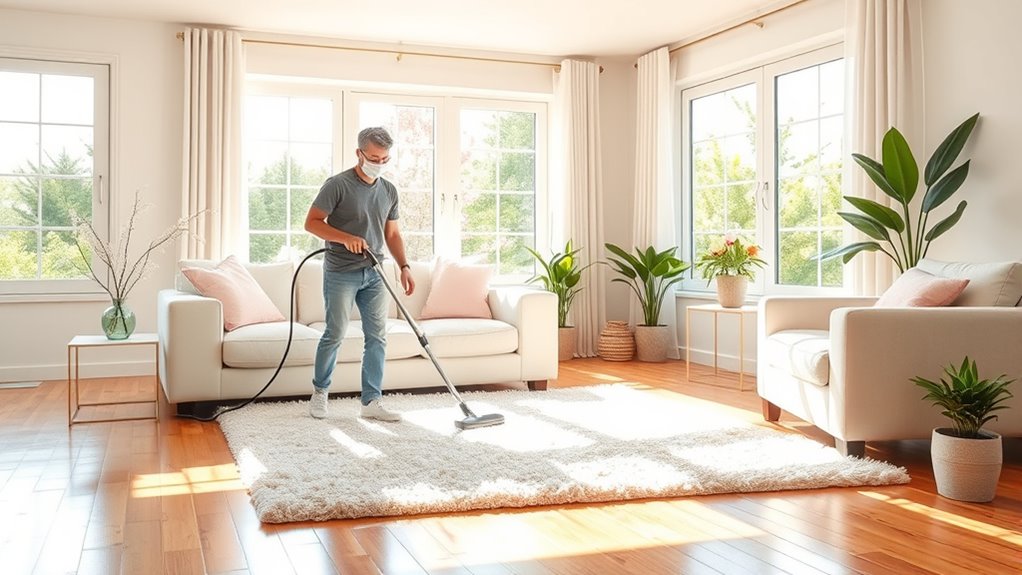
When tackling whole house deep cleaning, it’s important to prioritize areas where allergens tend to accumulate.
Start by changing your air filters every three months; opt for ones with a MERV rating of 11 or 12 to trap dust and pollen effectively.
Regular vacuuming is vital—use a cyclonic vacuum or one with HEPA filters to eliminate dust mites and pet dander from carpets and upholstery.
Wash your bedding weekly in water heated to at least 130°F to combat dust mites.
Over several days, conduct a thorough clean of high-traffic areas to remove dust, mold, and other allergens.
Finally, consider using allergen-proof covers on mattresses and pillows, washing them periodically to maintain a cleaner sleep environment.
Outdoor Allergy Precautions
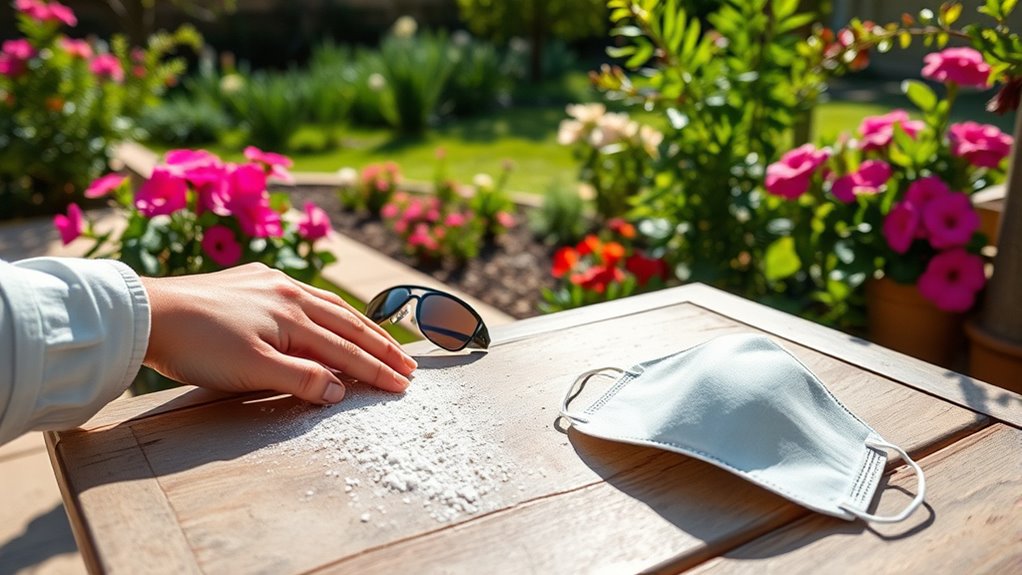
As pollen counts peak during midday and afternoon, steering clear of outdoor activities at these times can greatly reduce your allergy exposure.
If you must be outside, wear gloves and an N95 mask while gardening or mowing to protect yourself from allergens and minimize skin irritation.
Taking allergy medication before heading out can help manage symptoms and provide relief from pollen-related reactions.
It’s also wise to stay informed about local pollen levels through weather reports or apps, so you can plan your activities accordingly.
When you return indoors, wash your hands, hair, and clothes immediately to remove any pollen that may have accumulated during your time outside.
These precautions will help you enjoy spring while keeping your allergies in check.
Dust Everything

To keep allergens at bay, dust everything in your home regularly.
Use effective techniques, like microfiber cloths, to trap dust and target high-dust areas such as ceiling fans and shelves.
Effective Dusting Techniques
Dusting is an essential task for maintaining a clean environment, especially for allergy sufferers. Use a microfiber cloth for dusting; it effectively traps allergens without sending them airborne.
Make sure to wipe down all surfaces, including countertops, shelves, and those hard-to-reach areas like ceiling fans and cabinet tops. This systematic approach helps eliminate accumulated dust. Start from the top of the room and work your way down, allowing dust to settle on lower surfaces for easy cleanup.
After dusting, vacuum carpets, fabric furniture, and mattresses weekly with a vacuum equipped with a HEPA filter to capture dust mites.
Always wear a mask while dusting to minimize your exposure to allergens and protect your respiratory health.
Target High-Dust Areas
Cleaning high-dust areas is an essential part of your allergy management strategy. Dust is a cocktail of contaminants, including dust mites and allergens, and it builds up in high-dust areas like ceiling fans, the tops of cabinets, and light fixtures.
Use a microfiber cloth to effectively trap dust particles, preventing them from becoming airborne. Regular vacuuming of carpets, fabric furniture, and mattresses is vital; wearing a mask while you clean can help shield you from allergic reactions.
Don’t forget to target hard-to-reach spaces, such as behind appliances and under furniture, as these spots can greatly contribute to dust accumulation.
Stop Mold From Growing
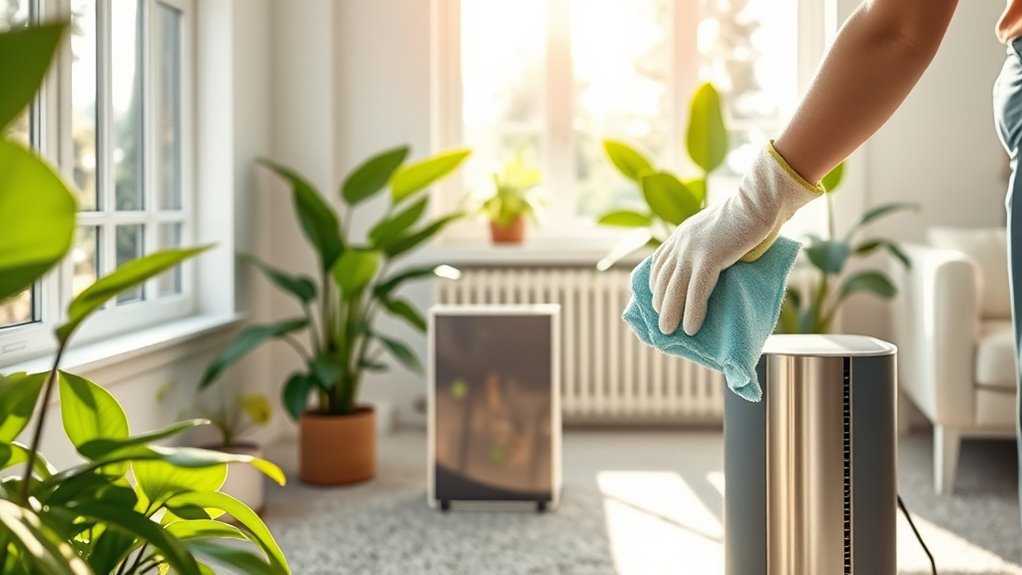
Since mold thrives in warm, damp environments, keeping your home dry and well-maintained is crucial in preventing its growth. Regularly clean bathrooms and kitchens with soap and warm water to eliminate mold spores. Address maintenance issues like leaks and guarantee proper ventilation to reduce humidity levels. Keep indoor humidity below 60% using dehumidifiers, which helps improve air quality and inhibits mold growth.
| Action | Purpose |
|---|---|
| Clean surfaces | Eliminate mold spores |
| Fix leaks | Prevent moisture accumulation |
| Use dehumidifiers | Control humidity levels |
| Check for mold signs | Catch issues early |
Listen to Your Body

Keeping an eye on your body’s responses to allergens is essential for managing your symptoms effectively.
You should tailor your cleaning approach based on your specific sensitivities. Here are some tips to help:
- Monitor your body’s reactions during and after cleaning. Adjust your methods if symptoms arise.
- If dust and pollen trigger your allergy symptoms, keep windows closed during high pollen times and use air purifiers to enhance indoor air quality.
- Conversely, if mold is a concern, consider airing out your home post-cleaning to reduce moisture buildup.
Pay attention to how your environment affects your allergies, allowing you to make informed choices about your cleaning frequency and techniques.
This proactive strategy can greatly improve your comfort this spring.
Next Steps & Resources
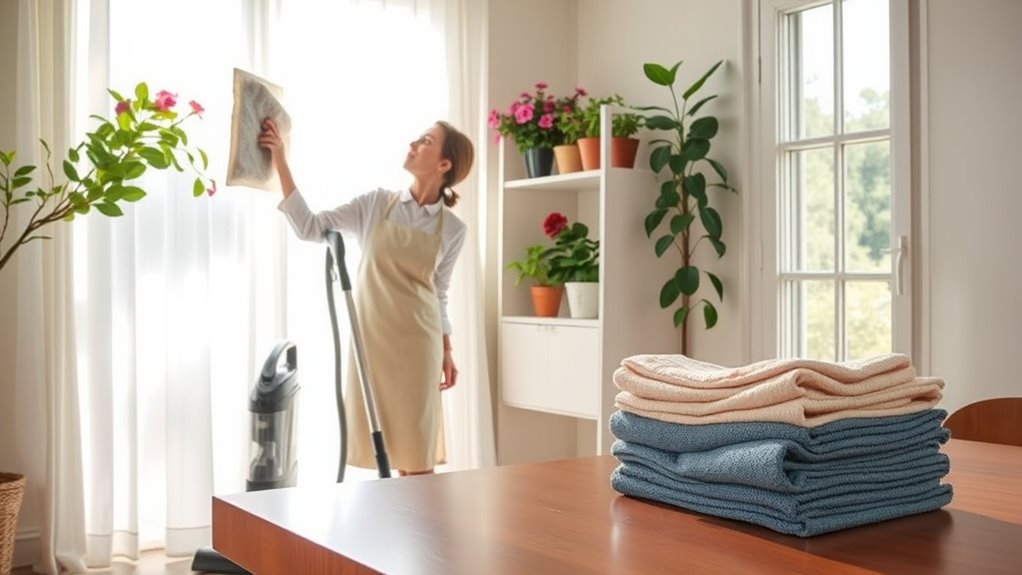
As you navigate your allergy management journey, knowing where to turn for help can make a significant difference. To effectively manage your allergies and asthma, consider reaching out to a professional medical organization or locate an allergist like Jared Goldfarb, M.D. at 800-822-8905. You can also explore online booking systems for convenience.
Here’s a quick reference table to guide your next steps:
| Resource | Purpose |
|---|---|
| Allergist Appointment | Personalized advice for managing allergies |
| Weekly Newsletter | Tips for reducing allergy symptoms |
| MERV Rating Information | Guidance on effective vacuuming frequently |
Utilizing these resources can help you create a healthier living environment this spring.
Related Topics
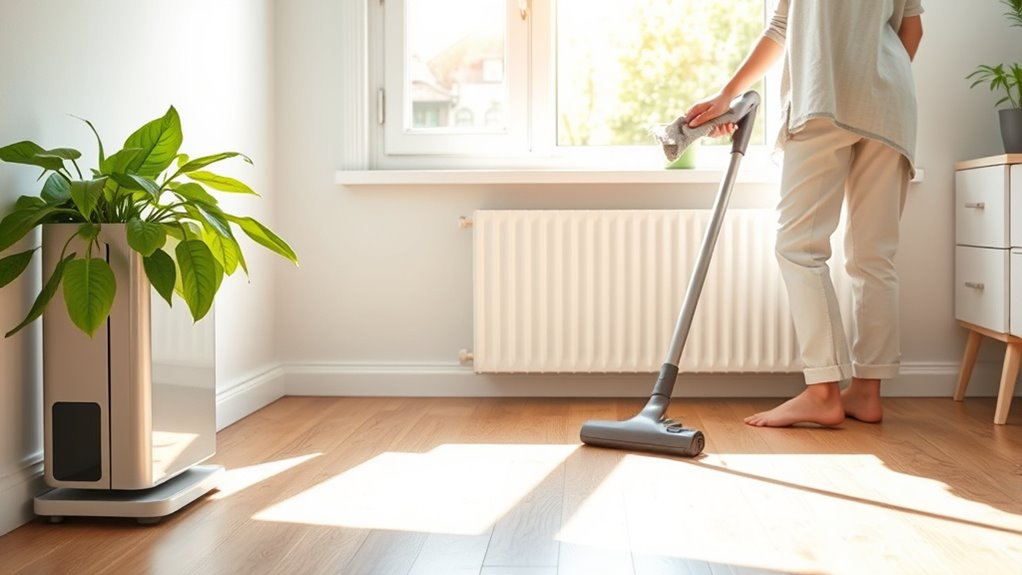
Exploring related topics can deepen your understanding of allergy management and enhance your overall well-being.
To effectively manage spring allergies, consider these strategies:
- Use air filters every three months to keep your indoor air clean. This helps capture allergens and improves air quality.
- Keep your windows closed during peak pollen season to prevent outdoor allergens from entering your home.
- Vacuum frequently and wash bedding weekly to remove dust and dirt away, reducing asthma triggers.
Identifying specific triggers like pollen or dust is essential for effective management.
Identifying your specific triggers, such as pollen or dust, is crucial for effective allergy management.
By taking these proactive measures, you can create a healthier living environment and enjoy a more comfortable spring season.
Frequently Asked Questions
How to Clean Without Triggering Allergies?
To clean without triggering allergies, start by using microfiber cloths to trap dust instead of spreading it around.
Wear an N95 mask and goggles to shield yourself from airborne allergens.
Choose chemical-free solutions like vinegar and baking soda to minimize irritation.
Vacuum with a HEPA filter-equipped vacuum cleaner to capture small particles effectively.
Finally, schedule your cleaning sessions during low pollen times, like early mornings or after rain, for ideal comfort.
What Is the Most Effective Cleaning Method for Removing Allergens?
They say, “A clean home is a happy home,” and when it comes to removing allergens, that rings especially true.
You’ll want to use a vacuum with a HEPA filter to trap dust, dander, and pollen effectively.
Don’t forget to wash bedding and curtains in hot water regularly.
Dust with microfiber cloths to capture particles, and keep humidity below 60% to prevent mold.
Following a consistent cleaning routine will make a significant difference!
Does Wearing a Mask While Cleaning Help With Allergies?
Yes, wearing a mask while cleaning definitely helps with allergies. It filters out at least 95% of airborne particles, including dust, mold spores, and pet dander that can trigger your symptoms.
By using an N95 mask, you’re minimizing your exposure to these irritants and protecting yourself from chemical fumes in cleaning products.
Combining the mask with proper cleaning techniques can greatly improve your indoor air quality and reduce allergy flare-ups considerably.
What Is the Best Cleaner to Use if You Have Allergies?
If you have allergies, the best cleaners to use are homemade solutions or certified allergy-friendly products.
Mixing baking soda and vinegar creates an effective, less irritating cleaner. Avoid harsh chemical cleaners, air fresheners, and scented candles, as they can trigger your symptoms.
Instead, opt for vacuum cleaners with HEPA filters to capture allergens. Regularly changing your air filters can also help improve indoor air quality, making your space more comfortable.
Conclusion
As spring blooms around you, let your home transform into a sanctuary free from allergens. Just like the flowers need care to thrive, your indoor space deserves the same attention. By embracing these cleaning tips, you’re not just clearing dust; you’re cultivating a breath of new vitality. Remember, your well-being is the garden you nurture, so listen to your body and take these steps to guarantee it flourishes this season. Enjoy a vibrant, allergy-free spring!

